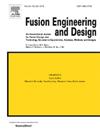The impact of stray magnetic fields on the KSTAR NBI performance
Abstract
The stray magnetic fields generated by a plasma discharge impact the performance of neutral beam injection (NBI), leading to a decline in the plasma performance of the Korea Superconducting Tokamak Advanced Research (KSTAR). To evaluate the impact of the stray magnetic field on the NBI performance, a Monte Carlo simulation tool was developed. The simulation tool integrates the stray magnetic fields, NBI beam line components, and charge exchange processes comprehensively, allowing for quantitative analysis of the NBI performance reduction due to the stray magnetic fields. The high pressure of the beam chamber, along with the stray magnetic fields, causes a significant reduction of the beam power, emphasizing the need to maintain low vacuum pressure. However, the stray magnetic field does not significantly affect the injection angle of the beam particles reaching the tokamak. Predictive integrated simulations show that the decrease in beam performance due to stray magnetic fields can affect a degradation in plasma performance during long pulse discharge in KSTAR.

 求助内容:
求助内容: 应助结果提醒方式:
应助结果提醒方式:


